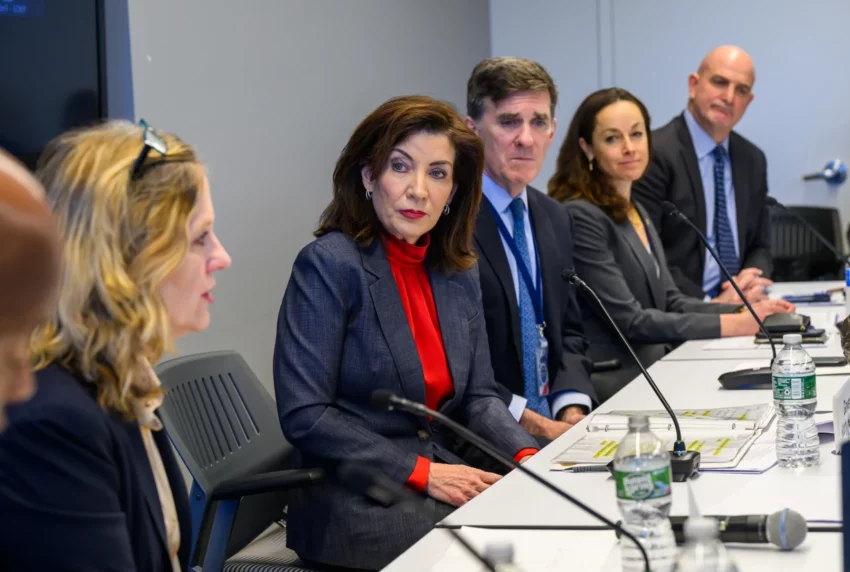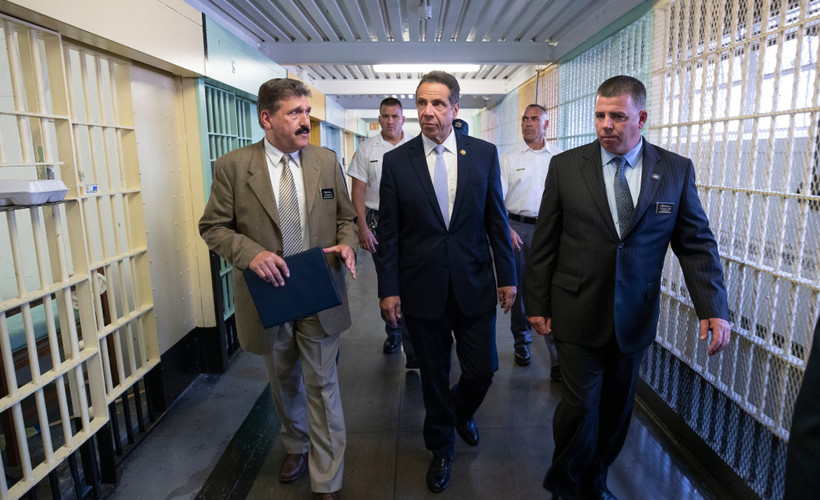GOVERNOR KATHY HOCHUL has made no secret of her goal to scale back state spending across agencies. But among some rural state lawmakers, her plan to save $77 million on prisons is driving backlash.
This story originally appeared in New York Focus, a non-profit news publication investigating how power works in New York state. Sign up for their newsletter here.
BY: Eliza Fawcett
The savings would come from Hochul’s proposal to close up to five correctional facilities in the next fiscal year. The move, her office says, would allow the state to “right-size and eliminate excess capacity” in its prison system. The process has been in the works for decades: New York’s prison population has shrunk by more than 30,000 people since 2003, and Andrew Cuomo closed 18 facilities while governor. In 2022, Hochul shuttered six more.
Still, the state’s prison system remains far from “right sized.” A New York Focus analysis of data from the Department of Corrections and Community Supervision found that as of this month, nearly half of New York’s 44 state prisons are less than 70 percent full, a dozen of them less than 60 percent full. In some cases, the most vacant facilities are the most troubled: Washington County’s Great Meadow Correctional Facility — which in recent years had the highest rate of suicide of any state prison and one of the highest rates of recorded staff violence — was barely 30 percent full at the start of this month.
doccs hasn’t identified which facilities it might close, though Great Meadow could be on the chopping block if Hochul’s proposal passes. But a cohort of Republican state lawmakers, as well as some Democrats from rural areas, are staunchly opposed to the measure, warning that closures could increase violence in the remaining facilities and drive correctional officers out of the profession. They particularly object to a provision that would allow the state to close prisons with 90 days’ notice, accelerating a process that currently takes a year.
“A 90-day prison closure, that’s an insult and slap in the face to these brave men and women who work this dangerous job to keep us safe,” Assemblymember Philip Palmesano, a Republican representing parts of the Southern Tier and Finger Lakes, said in an interview.
The Democratic-led legislature has repeatedly authorized state prison closures, including on expedited timelines. And doccs says the closures are about more than just empty beds. During a budget hearing last month, acting commissioner Daniel Martuscello iii told lawmakers that the closures would help alleviate an “unsustainable” staffing crisis.
“It’s not an easy decision to close prisons, but because of the excess capacity, this will allow staff to have that balance and reduce our vacancy rate,” Martuscello said. New York prisons have 3,800 vacant positions, he said, half of them correctional officers — enough that doccs could absorb every employee affected by closures.
Nationwide, state prisons face severe staffing shortages and have struggled to recruit and retain staff. In New York, the most acute staffing needs are among civilian employees, like health services workers, who have an outsized impact on how people fare in prisons. When it comes to correctional officers, New York prisons are the most robustly staffed in the country. And while Hochul’s proposal seeks to both resolve staffing issues and save the state money, the promised multimillion-dollar savings from past prison closures remain elusive.
NEW YORK’S ERA of prison closures follows a late 20th century prison building boom. Under three-term governor Mario Cuomo, New York built 30 new prisons — and filled them up. The state’s prison population more than doubled between the early 1980s and the early 1990s, and reached a peak of 72,773 in 1999.
The population has since fallen by more than half: As of January 1, there were 32,766 people locked up in New York’s state prisons. While the state has closed 24 of them since 2011, many more remain open and are increasingly empty.
Empire State of Decarceration
New York prisons have struggled to fill security positions over the past five years. The incarcerated population has been on the decline for decades.
2004200620082010201220142016201820202022010,00020,00030,00040,00050,00060,000
Great Meadow had more than 1,100 vacant beds as of February 1, according to a New York Focus data analysis, while three prisons in the North Country and one in the Finger Lakes region each had more than 600 empty beds, putting them at a third to nearly half empty. (In 2021, when Hochul announced plans to close Downstate Correctional Facility in the Hudson Valley, it was operating at 56 percent capacity.)
New York’s correctional staffing levels haven’t declined at the same rate as its prison population. Over the past two decades, doccs lost 27 percent of filled security positions, compared to 50 percent of its incarcerated population. In that time, the department’s staffing ratio, or the number of incarcerated people per uniformed security staffer, declined from just over three to about two. From 2019 to 2023, despite losing more than 4,000 filled security positions, doccs’s staffing ratio continued to hover around two.
This puts New York at a tie with Vermont for the country’s lowest prison staffing ratio, according to federal data. Vermont has a much smaller incarcerated population than New York does; more comparable states, like Pennsylvania, Florida, and Ohio, reported staffing ratios that were two to four times higher.
But New York’s low ratio elides the most acute source of staffing vacancies: not correctional officers, but health services staff, program staff, and support staff. According to the Correctional Association of New York (cany), a nonprofit oversight group, 25 percent of health services positions, 19 percent of support services positions, and 17 percent of program services positions were vacant as of last January, compared to five percent of security staff positions.
“The fact that there just aren’t enough medical staff means that people are waiting much longer for access to providers, access to routine dental cleanings,” said Jennifer Scaife, cany’s executive director. “Some facilities just don’t have a dentist.”
At Sullivan Correctional Facility, cany found that 22 out of 40 medical staff positions were vacant as of last January; at Bedford Hills Correctional Facility, 43 out of 73 program staff positions were unfilled.
For incarcerated people, staffing shortages can significantly diminish day-to-day conditions. Tanya Krupat, Osborne Association’s vice president of policy and advocacy, said the shortages have curtailed her organization’s ability to deliver its programming in prisons, which includes parenting classes and child friendly spaces in visiting rooms. At times, Krupat said, Osborne employees travel to a prison only to find upon arrival that “they’re not allowed in because programming is closed due to a lack of staff.”
This hasn’t been the focus of prison officials and correctional officers’ labor representatives. Testifying in Albany last month, Martuscello said that the 1,900 correctional officer vacancies across doccs — and their impact on the system’s remaining workers — keep him up at night.
“A 90-day prison closure, that’s an insult and slap in the face.”
“They are overworked, they’re burnt out, they’re working doubles, they’re giving up time with families,” he said.
Chris Summers, the president of the New York State Correctional Officers and Police Benevolent Association, argued in the budget hearing that closures will exacerbate staffing issues, not solve them, by driving staff into early retirement or other lines of work.
“Our frontline staff feels like the budget is being balanced on their backs,” he said.
Palmesano and other Republican lawmakers have argued that consolidating the state’s incarcerated population could increase violence. They have attributed rising incidents of assault in prisons — against both staff and incarcerated people — to the passage of New York’s law limiting the use of solitary confinement. (While doccs has seen an increase in reported assaults against staff, most have resulted in minor injuries or no injuries, according to Martuscello. Some research indicates that greater numbers of correctional officers relative to incarcerated people correlate with higher rates of violence against staff.)
“The administration’s answer to the problem is, ‘Let’s put more violent offenders into fewer facilities,’” Palmesano said.
UNDERPINNING BACKLASH to Hochul’s proposal is a deep economic anxiety from lawmakers representing rural parts of New York where state prisons have long been major employers. This is particularly pronounced in the North Country, where the state has closed eight correctional facilities since 2009.
Senator Daniel Stec, a Republican who represents much of the North Country, stressed in last month’s budget hearing that the state shouldn’t shut down additional facilities without first repurposing the ones it has already closed. He described a 2022 report from the state Prison Redevelopment Commission, which analyzed options for shuttered prisons, as “140 pages of fluff.”
Hochul’s office estimates her proposal would save the state $77 million in the coming fiscal year and $128 million annually in subsequent years. The 24 facilities that doccs has closed since 2011 have resulted in an annual savings of approximately $442 million, according to doccs.
But despite all those closures, it’s unclear where, exactly, those savings have gone. Between 2011 and 2021 — a decade of frequent prison closures — the state’s total correctional spending per incarcerated person increased by more than 79 percent, according to an analysis from the Vera Institute of Justice. As of 2023, the doccs budget was a billion dollars higher than it was in 2003, despite having half as many people under its supervision. doccs’s practice of relocating employees during closures rather than instituting layoffs may have curtailed savings from past closures, creating “severe overstaffing” in some facilities, according to Vera.
And as for redeveloping the former sites, the Democrat and Chronicle reported in 2019 that the $82 million the state had pledged since 2011 to support communities facing prison closures had gone mostly unspent, and many communities have struggled to attract developers.
In public comments in the North Country last month, Hochul emphasized that the state was “working really hard with the local communities to reimagine those properties,” and likened the sites to “college campuses” that “lend themselves to so many great opportunities.” She also reiterated the state’s commitment to preserving the jobs of workers impacted by potential closures.
“People are waiting much longer for access to providers. Some facilities just don’t have a dentist.”
“The problem we have right now is we also have a severe shortage of corrections officers. We have a workforce shortage,” she said. “So, every person whose home facility closes will absolutely find another opportunity. We commit to that.”
Senator Brad Hoylman-Sigal, a Manhattan Democrat and chair of the Senate judiciary committee, supports Hochul’s closure proposal, but argued that the state should also explore other forms of decarceration, like parole reform.
“There are too many New Yorkers behind bars, especially older incarcerated individuals,” Hoylman-Sigal said in a statement. “Closures are one way to hasten this effort, but we should also consider shifting the correctional system away from focusing solely on incarceration to offering incarcerated people more meaningful opportunities for rehabilitation and reentry into their communities.”
New York doesn’t need to keep increasingly vacant prisons open, but deeper investments are also needed to reimagine the state’s workforce, said Jullian Harris-Calvin, the director of Vera’s Greater Justice New York program.
“Where the state really should be looking is to figure out, ‘How can we transition corrections staff, and the local economies that really survive off of the prison structures there, so that we don’t have to trade one harm for another in these communities?’” she said. “And we’re not seeing very much at all of that coming from our state government.”




